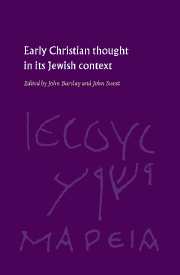Book contents
- Frontmatter
- Contents
- List of contributors
- Preface
- List of works by Morna D. Hooker
- List of abbreviations
- Chapter 1 Introductory Essay
- I THE SOCIAL CONTEXT OF EARLY CHRISTIANITY
- II SOME EARLY CHRISTIAN SOURCES
- Chapter 4 Jesus
- Chapter 5 Matthew
- Chapter 6 Mark
- Chapter 7 Luke–Acts
- Chapter 8 John
- Chapter 9 Paul
- Chapter 10 Deutero-Pauline letters
- Chapter 11 Hebrews
- Chapter 12 Revelation
- Chapter 13 Other early Christian writings: ‘Didache’, Ignatius, ‘Barnabas’, Justin Martyr
- III SOME EARLY CHRISTIAN THEMES
- Index of names
- Index of subjects
- Index of texts
Chapter 5 - Matthew
from II - SOME EARLY CHRISTIAN SOURCES
Published online by Cambridge University Press: 22 September 2009
- Frontmatter
- Contents
- List of contributors
- Preface
- List of works by Morna D. Hooker
- List of abbreviations
- Chapter 1 Introductory Essay
- I THE SOCIAL CONTEXT OF EARLY CHRISTIANITY
- II SOME EARLY CHRISTIAN SOURCES
- Chapter 4 Jesus
- Chapter 5 Matthew
- Chapter 6 Mark
- Chapter 7 Luke–Acts
- Chapter 8 John
- Chapter 9 Paul
- Chapter 10 Deutero-Pauline letters
- Chapter 11 Hebrews
- Chapter 12 Revelation
- Chapter 13 Other early Christian writings: ‘Didache’, Ignatius, ‘Barnabas’, Justin Martyr
- III SOME EARLY CHRISTIAN THEMES
- Index of names
- Index of subjects
- Index of texts
Summary
Professor Hooker's Continuity and Discontinuity makes a number of suggestions regarding the relationship of Matthew's gospel to Judaism. She notes that the parable of the wine and the wineskins appears in all three synoptic gospels as part of a debate concerning Jewish religious groups who do fast and Jesus' disciples who do not fast, and she observes that Matthew is interested in preserving both wine and wineskins (Matt. 9.17d). This chapter gives support to her conclusion. She sees Matthew's preservation of both wine and wineskins as achieved through a holding together of the revelation of God's will which was given in the past with the new understanding of that will which has come through Jesus, by a refusal to regard the former as wrong, and by the treatment of the latter as its fulfilment. Again Professor Hooker's solution is well-justified; fulfilment is the key to the Matthean reconciliation of the old with the new. A third area of research indicated by Professor Hooker provides the main concern of this chapter: the setting in which the debate between old and new took place. To judge by Matthew 23, that setting involved a very vigorous debate between Jews and Christians. But what was the nature of the debate? Who were the main participants? Given the continuity of the old with the new in Matthew's gospel, and the debate concerning them, what was its setting in relation to Judaism?
- Type
- Chapter
- Information
- Early Christian Thought in its Jewish Context , pp. 59 - 69Publisher: Cambridge University PressPrint publication year: 1996
- 1
- Cited by



